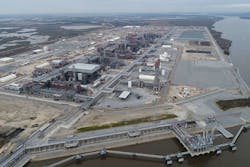EIA: U.S. top Global LNG producer, exporter so far in 2022
The United States is the world’s largest liquefied natural gas (LNG) exporter for the first half of 2022, according to the federal Energy Information Administration.
Quoting CEDIGAZ, a global association of natural gas producers, the EIA report estimated that U.S. LNG exports averaged 11.2 billion cubic feet per day. The daily average for the six first months of this year was 12 percent higher than in the second half of 2021.
Demand from Europe as it deals with decreased consumption from Russian natural gas is a driving factor in the daily export levels. Installed U.S. LNG export capacity also expanded by 1.9 billion cubic feet, thanks to new projects such as a sixth liquefaction train at the Sabine Pass LNG terminal owned by Cheniere Energy along the Louisiana Gulf Coast.
U.S. natural gas production has grown by leaps in the past two decades, thanks to innovations in hydraulic fracturing and directional drilling. Global partners are looking for options to Russian and Middle East energy production, with companies such as Sempra and Cheniere investing billions of dollars to create new LNG export facilities.
See our full coverage of LNG projects
Subscribe to EnergyTech's free newsletter for regular Insights into the C&I Energy Transition
Most of the U.S. LNG exports went to the European Union and the United Kingdom in the first half of this year. Nearly 8.2 billion cubic feet per day moved from the U.S. terminals to those markets, according to EIA.
Methane natural gas used in power generation emits only about half of the carbon emissions of coal-fired power, according to reports. Many see it as both a bridge fuel to Net Zero goals and an alternative to problematic exporters such as Russia, which invaded Ukraine earlier this year, and Saudi Arabia, long criticized for human rights violations.
Natural gas is chilled to minus 260 degrees Fahrenheit (162 Celsius) to convert it into liquid form and make it more stable for shipping. Once delivered to markets it is imported to regasification units for use in power plants and district heating.
About the Author
Rod Walton, EnergyTech Managing Editor
Managing Editor
For EnergyTech editorial inquiries, please contact Managing Editor Rod Walton at [email protected].
Rod Walton has spent 17 years covering the energy industry as a newspaper and trade journalist. He formerly was energy writer and business editor at the Tulsa World. Later, he spent six years covering the electricity power sector for Pennwell and Clarion Events. He joined Endeavor and EnergyTech in November 2021.
Walton earned his Bachelors degree in journalism from the University of Oklahoma. His career stops include the Moore American, Bartlesville Examiner-Enterprise, Wagoner Tribune and Tulsa World.
EnergyTech is focused on the mission critical and large-scale energy users and their sustainability and resiliency goals. These include the commercial and industrial sectors, as well as the military, universities, data centers and microgrids. The C&I sectors together account for close to 30 percent of greenhouse gas emissions in the U.S.
He was named Managing Editor for Microgrid Knowledge and EnergyTech starting July 1, 2023
Many large-scale energy users such as Fortune 500 companies, and mission-critical users such as military bases, universities, healthcare facilities, public safety and data centers, shifting their energy priorities to reach net-zero carbon goals within the coming decades. These include plans for renewable energy power purchase agreements, but also on-site resiliency projects such as microgrids, combined heat and power, rooftop solar, energy storage, digitalization and building efficiency upgrades.

